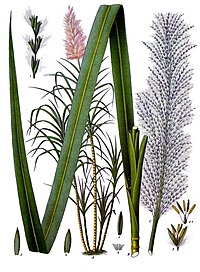
Photo from wikipedia
Sorghum is feed/industrial crop in the developed countries and a staple food in the rest of the world. In this study, we evaluated the sorghum mini core (MC) collection for… Click to show full abstract
Sorghum is feed/industrial crop in the developed countries and a staple food in the rest of the world. In this study, we evaluated the sorghum mini core (MC) collection for days to 50% flowering (DF), biomass (BM), plant height (PH), soluble solid content (SSC) and juice weight (JW) and the sorghum reference set (RS) for DF and PH in 7-12 testing environments and performed association mapping with 6,094,317 SNP markers in the MC and 265,500 SNPs for the RS. We identified in the MC panel three QTLs for DF, one for PH, one for BM, and two for JW. In the RS panel we identified another PH QTL on chromosome 6 also associated with DF, BM, JW, and SSC in the MC panel. Transgenic studies of three genes selected from the locus revealed that Sobic.006G061100 (SbSNF4-2) increased BM, SSC, JW, and PH when overexpressed in both sorghum and sugarcane and delayed flowering in transgenic sorghum. SbSNF4-2 encodes a γ subunit of the evolutionarily conserved AMPK/SNF1/SnRK1 heterotrimeric complexes and overexpression of human or mouse γ2 in heart or the whole body also increases heart or body biomass. SbSNF4-2 and its orthologs will be valuable in genetic enhancement of biomass and sugar yield in plants.
Journal Title: Journal of experimental botany
Year Published: 2022
Link to full text (if available)
Share on Social Media: Sign Up to like & get
recommendations!